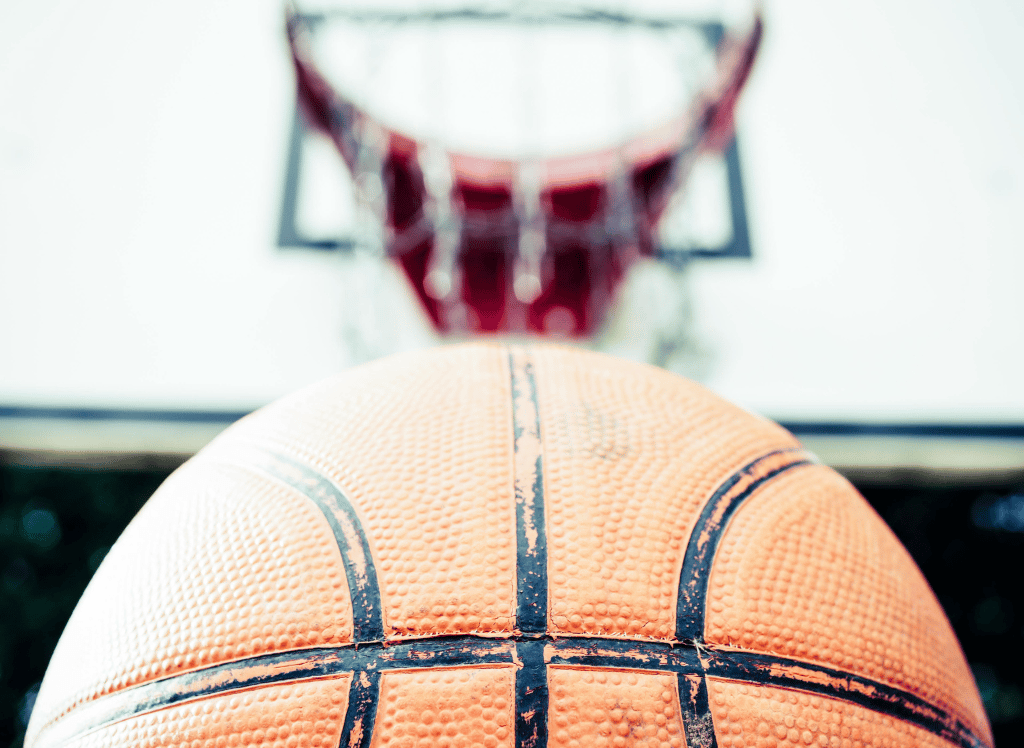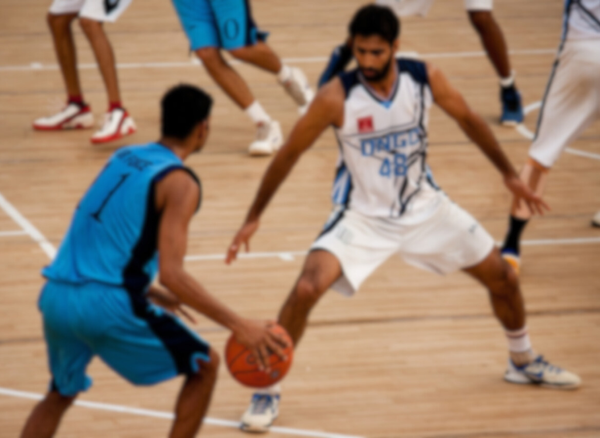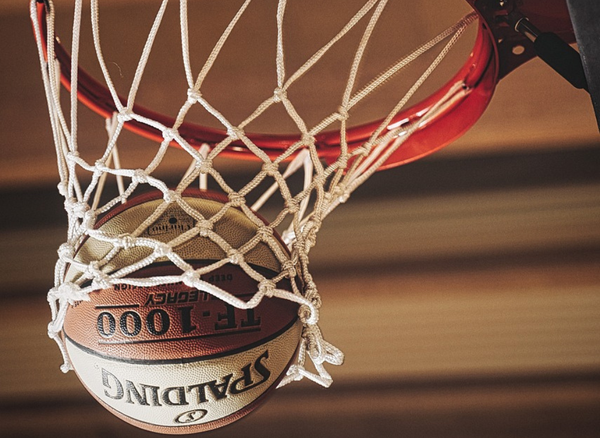Basketball is a game of swift moves, sharp shooting, and slick dribbling. But what really gets the crowd roaring is a well-executed crossover that leaves defenders grasping at air. Let's move into the world of crossovers and break it down, shall we?
What is a crossover in basketball?
The crossover move involves a ball handler swiftly switching the ball from one hand to the other, right in front of a defender.
The crossover is a dribble move that's no joke. It's a dribble move that's as fun to perform as it is to watch. It's like telling the defender, "Look left, go right—just kidding!" and zipping past them before they can say "ankle insurance."
The key to a good crossover dribble is the element of surprise and a dash of deception. It's all about convincing the defensive player that you're going one direction, then crossing the ball to the opposite hand and taking off like a squirrel on espresso. It's a move that requires balance, hand eye coordination, and the ability to push the ball with just the right amount of sass.
The Anatomy of a Killer Crossover
To execute a great crossover, you need more than just a ball and a dream. You start with your dominant hand, let's say the right hand for giggles, dribbling the ball as you approach your unsuspecting victim—I mean, defender. With a quick bounce, you push the ball to your left hand, shifting your body weight and stepping to the left. The defender, who's probably already planning their next move, is caught off guard, and you blow by them, leaving them to question their life choices.
A killer crossover isn't just about speed; it's about timing and finesse.
You've got to sell the fake with your whole body, not just your hands. Your eyes, your knees, your legs, they all play a part in this basketball symphony. And when you pull it off, it's like hitting the high note in a solo that makes the crowd go wild.
The Basic Crossover
The basic crossover might sound like child's play, but it's a fundamental dribble move that even the pros respect. It's the bread and butter of ball handling, the foundation upon which all fancy footwork is built. A good crossover dribble can create space faster than a rumor spreads in high school.
To nail the basic crossover, you start with the ball in your dominant hand, say the right hand for consistency. You dribble towards the defender, and with a quick, low bounce to the left hand, you change direction. The trick is to keep the ball low and close, like you're whispering a secret to it that you don't want the defender to hear. It's a quick, clean move that says, "Excuse me, I've got a date with the basket."
Behind the Back Crossover
Now, the behind the back crossover is where things get spicy. It's like the basic crossover went on a tropical vacation and came back with a tan and a new attitude. This move is not just for show; it's a strategic masterpiece when done right. It's perfect for when you've got a defender crowding you like they're trying to read the label on your jersey.
To pull off this sassy maneuver, you dribble the ball towards the defender with your dominant hand, and instead of crossing in front, you wrap the ball behind your back to the opposite hand. It's a move that requires confidence, coordination, and the ability to not look like you're trying to swat a fly behind you. When executed correctly, it leaves defenders tangled up like a pair of earbuds in your pocket.
Double Crossover
If one crossover is good, a double crossover is like a double scoop of your favorite ice cream. It's a dribble move that says, "I'm not just here to play; I'm here to put on a clinic." The double crossover involves not one, but two rapid changes of direction, leaving defenders wondering if they accidentally stepped onto a dance floor.
Starting with the ball in one hand, you fake a crossover to the opposite hand but quickly bring it back to the starting hand. Then, as the defender scrambles to adjust, you hit them with the real crossover. It's a move that requires the dribbling finesse of a pianist and the deceptive grace of a magician pulling a rabbit out of a hat.
The Art of Creating Space with a Crossover
Creating space is like finding a parking spot in a crowded lot—it's essential. A good crossover dribble is your turn signal, indicating to defenders that you're about to slide into that open space. Whether you're looking to take a jump shot or drive to the basket, a crossover can give you those precious seconds you need.
The crossover allows you to change direction and speed with such abruptness that the defender has to respect your move. It's like a game of chicken, but instead of cars, it's you and the defender, and instead of a head-on collision, you're aiming for an open teammate or a clear path to the hoop.
The Crossover as a Signature Move
When you think of a basketball player with a signature move, you might picture Allen Iverson or Tim Hardaway. These guys didn't just do crossovers; they turned them into an art form. Iverson's killer crossover was so smooth, it should've come with a silk robe and a glass of fine wine.
And Hardaway's "UTEP Two-step" was like a dance move that could make even the stiffest defenders sway to the beat.
These legends used the crossover not just as a way to get past defenders, but as a statement. It was their way of stamping their personality onto the game, like a graffiti artist leaving their tag on the basketball court. And when they executed their move, it was as if they were saying, "This is my court, and you're just playing on it."
Practicing the Crossover
Practice might not make perfect, but it sure makes your crossovers a lot less embarrassing. Basketball drills are the veggies of the basketball diet—you might not love them, but they're good for you. To get that crossover tight, you can use two basketballs, dribbling them simultaneously to improve hand eye coordination. Or you can set up cones on the basketball court and weave through them like you're dodging paparazzi.
The key to practicing crossovers is repetition and variation. You want to work on crossing over from both the left hand to the right and vice versa. You want to practice at different speeds, in different directions, and under different levels of pressure. It's like preparing for a pop quiz—you never know what's going to be thrown at you, so you better be ready for anything.
The Crossover in Game Situations
You don't want to pull out a crossover just because you can; you want to use it when it's going to be most effective. When you see a defender overcommitting to one side, that's your cue to cross the ball to the opposite side and leave them in your dust.
A crossover is also a great way to reset the offense. If you're dribbling the ball up the court and the play isn't developing as you'd like, a quick crossover can give you a fresh look at the defense. It's like shaking an Etch A Sketch—you get to start over and create a new masterpiece.
The Psychological Impact of a Crossover
Let's not forget the mind games. A great crossover can get inside a defender's head faster than a catchy jingle. Once you've crossed someone over, they're going to be thinking about it the next time they guard you. It's like you've set up camp in their brain, and now they're second-guessing their every move.
This mental edge can be just as important as the physical advantage. When a defender is worried about getting crossed over, they're less likely to play tight defense, giving you more room to operate. It's a psychological chess match, and with a good crossover, you're playing with queen's gambit.
The Evolution of the Crossover
The crossover has come a long way since Tim Hardaway was breaking ankles in the '90s. Today's players have taken the move and added their own flavor, like chefs experimenting with a classic recipe. We've seen crossovers that involve spins, hesitations, and even the occasional nutmeg (passing the ball through a defender's legs).
As the game evolves, so does the crossover. Players are getting faster, more agile, and more creative. The crossover isn't just a move; it's a reflection of the player's personality and the ever-changing landscape of basketball. It's a move that says, "This is how I play the game, and good luck keeping up."
Crossover Move FAQ Section
Can a crossover be considered a travel in basketball?
No, a crossover is not considered a travel as long as the ball handler maintains their dribble and does not take more than the allowed steps without dribbling the ball.
How can I improve my crossover dribble?
To improve your crossover dribble, practice regularly with drills that focus on hand eye coordination, speed, and agility. Use two basketballs, dribble around cones, and practice changing direction quickly to enhance your skills.
Who are some basketball players known for their crossover move?
Allen Iverson and Tim Hardaway are two legendary players known for their killer crossover moves. Iverson's crossover was famously effective against Michael Jordan, and Hardaway's "UTEP Two-step" became his signature move.
Summary
The crossover in basketball is a fundamental dribble move that's as entertaining as it is effective. It's a way to create space, change direction, and leave defenders questioning their career choices. Whether it's the basic crossover, the behind the back, or the double crossover, this move is an essential part of any ball handler's arsenal. Practicing crossovers can improve hand eye coordination, balance, and overall dribbling skills. Remember, a great crossover isn't just about the physical move; it's about the mental impact it has on the game and the defender.









